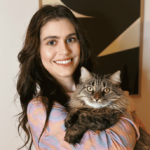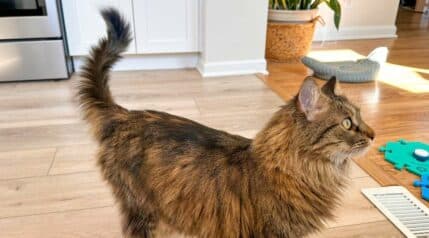When you purchase through links on our site, we may earn a commission. Here’s how it works.
If your hyperfocus is learning about rare cat breeds, you’ve undoubtedly heard of the German Rex and German Longhair. These felines are the only pedigreed cats originating in Germany and are still rare today.
Despite coming from the same country, these cats appear and act differently. The German Rex is a curly-coated cat with a huge personality. This rambunctious kitty is highly active and intelligent. As their name suggests, the German Longhair has a thick, long coat with a bushy tail and hair between their paw pads. This cat is even-tempered, friendly, and people-focused. Keep reading to learn more about these two unique cat breeds.
German Rex Cat

Breeders developed the German Rex after World War II when Dr. R. Scheuer-Karpin noticed a black, curly-haired cat playing in the gardens outside Hufeland Hospital in East Berlin. The cat’s wavy coat gave her the appearance of an adorable lamb, so the doctor named the kitten Lämmchen, or Little Lamb. In 1957, Lämmchen was bred to one of her wavy-haired offspring, creating the first litter of German Rex kittens.
Today, the German Rex remains a difficult breed to find. Only two primary cat fancier registries recognize the German Rex: the World Cat Federation (WCF) and the International Cat Federation. While the Cat Fanciers’ Association does not recognize the German Rex, it does recognize the similar-looking Cornish Rex and other curly-haired cat breeds.
The German Rex is a small to medium-sized cat with an average weight of eight pounds. The legs of the German Rex are slim, athletic, and in proportion to the body. The tail is medium length and tapers to a point. The German Rex has a round head, a strong chin, alert eyes, and curly whiskers. The ears will be large, appearing almost too big for this kitty’s head.
This breed has short, semi-wavy fur that is soft to the touch. Because this breed lacks guard hairs, their coat feels velvety smooth. A German Rex can have various coat colors and patterns, including white, cream, brown, cinnamon, black, tabby, shaded, bi-color, calico, smoke, and tortoiseshell.
The German Rex is intelligent, friendly, and extremely playful. This fun-loving cat is always up to something and requires lots of toys and play to stay entertained. If you’re lucky enough to find a German Rex, you’ll discover they pick up tricks quickly and will entertain the whole family with their over-the-top curiosity and kitten-like antics.
German Longhair Cat

First discovered in 1929, the German Longhair is a natural breed that, despite its long history, has yet to be recognized for championship status by any major cat organization. Traditionally, the German people called local long-haired cats by the generic name Angoras. When biologist and zoologist Dr. Friedrich Schwangart met these “Angora” cats, he created a breed standard to differentiate the now-named German Longhairs from the British-style Persian cat, which shared many physical similarities to the German Longhair. Following World War II, the German Longhair was believed to be extinct. However, breeder Mrs. R Aschemeier found two and bred them to reestablish the breed.
Today, the German Longhair is still a rare breed outside of their native country. Thanks to careful breeding—with a focus on genetic diversity and healthy cats—this is a highly healthy breed that is free of breed-typical health problems. The German Longhair is the only native long-haired cat in Germany.
This cat has sturdy legs like the Persian that are short to medium-long, ending in large paws. The German Longhair has a medium-length, bushy tail that tapers to a round tip. This kitty has a round head, sloping nose, and large, slanted oval eyes. This breed has small to medium-sized ears that are broad at the base with a rounded point.
The silky, dense coat of the German Longhair is medium-length and lays close to the body. Coats come in various colors and patterns, excluding chocolate, cinnamon, and their dilutes. Overall, breeders describe this cat as moderate in appearance, with all characteristics medium-ranged and showing no extremes.
German Longhairs are social, playful, and cuddly. This cat has a relaxed temperament and makes a great housemate for people of all ages.
10 Other European Cat Breeds
While only two domestic cat breeds originated in Germany, many other cat breeds developed throughout Europe:
- Chartreux– Originating in France, fanciers love the Chartreux for their plush blue-gray coat, copper eyes, and stocky body. These quiet kitties are extraordinarily affectionate and love spending time with their family.
- Cornish Rex– The first Cornish Rex was born in Cornwall, England. Sometimes referred to as the Greyhound of cats, the Cornish Rex has a sleek appearance with a short, curly coat.
- Devon Rex– The Devon Rex hails from England. People love this cat for their “pixie” appearance, with a small, slender body, expressive eyes, and huge ears.
- European Shorthair– Legend says Romans were responsible for bringing these cats to the rest of Europe. This breed is one of the most popular house cat breeds.
- Manx– The Manx comes from the Isle of Man, a small island between Great Britain and Ireland. Manx cats are born without tails or with shortened tails.
- Norwegian Forest Cat– The Norwegian Forest Cat originated in Norway. People often call this active, energetic breed a “gentle giant,” though they aren’t as large as their descendant, the Maine Coon.
- Russian Blue– As their name suggests, Russian Blues comes from Russia. These cats have blue coats like the Chartreux but have slimmer bodies and green eyes. The curious kitty acts shy around strangers and is more reserved than other cat breeds.
- Scottish Fold– From Scotland, the Scottish Fold can be easily recognized by their owl-like appearance: round face, round eyes, and folded ears.
- Siberian– Another feline from Russia, fanciers believe the Siberian cat to be closely related to the Norwegian Forest Cat but tends to be smaller with a more mellow personality. Despite their long coat, the Siberian cat is considered more allergy-friendly than most cat breeds.
- Ukrainian Levkoy– From Ukraine, the Ukrainian Levkoy is a new cat breed that is a cross of the hairless Donskoy cat and the Scottish Fold. This hairless kitty has a playful and affectionate personality.
Frequently Asked Questions
Is The Nebelung Cat German?
Though the name Nebelung, or “creature of the mist,” is German, this breed actually originated in the United States.
How Much Do German Cats Cost?
Because of their rarity, you’re unlikely to find the German Rex or German Longhair at a rescue or shelter. A pedigreed kitten will cost at least $1,000 for either breed.
Final Thoughts
If you’re curious about other rare cat breeds, check out our profiles on the Kinkalow, Cheetoh, and Dragon Li. Or, learn about the 19 most popular cat breeds worldwide.





